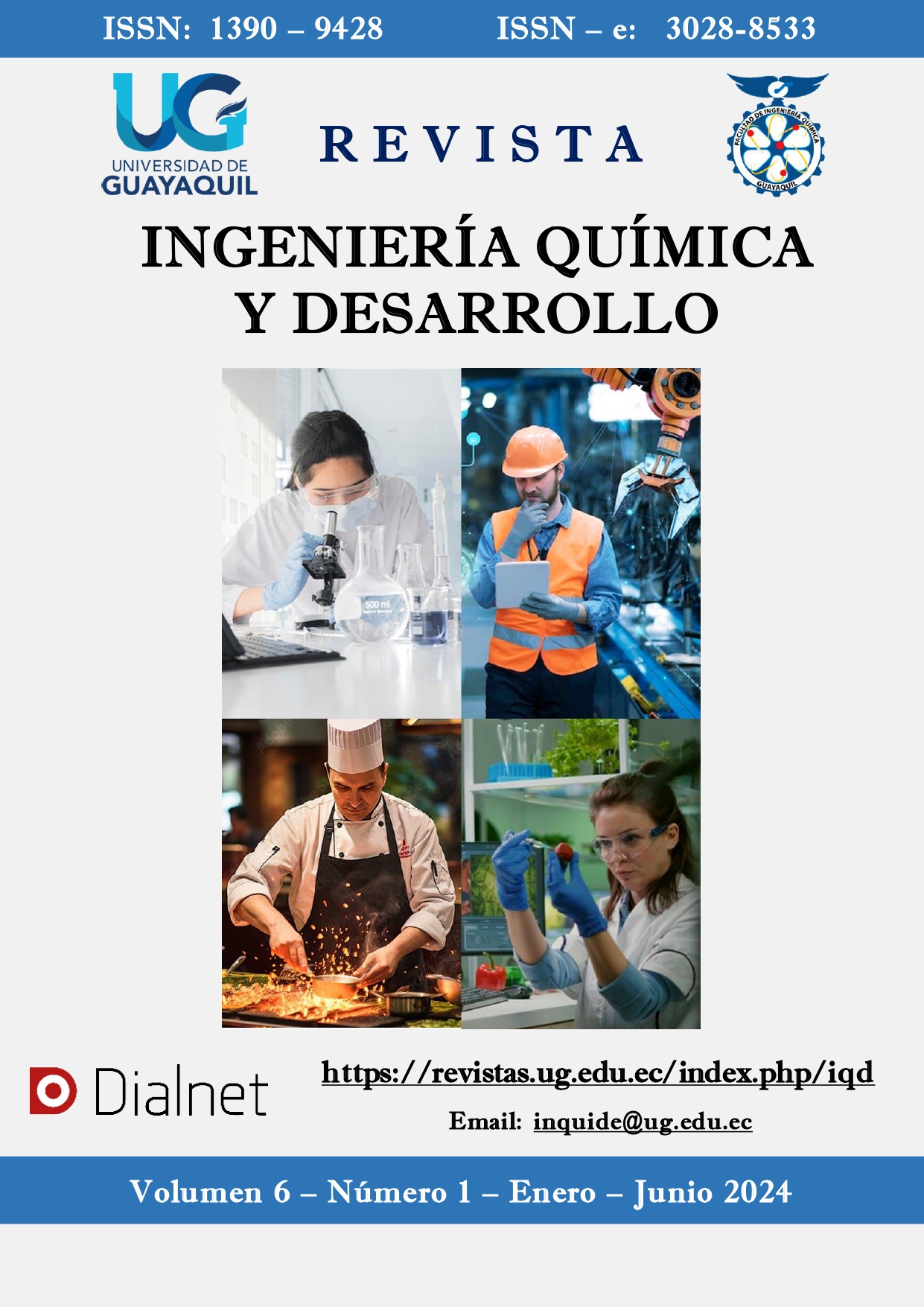Estimation of production efficiency in the extraction of essential oil from orange peel using neural networks
Main Article Content
Abstract
In this work, a feedforward Artificial Neural Network (ANN) with 9 hidden layers and backpropagation (BP) training algorithms and Levenberg-Marquardt (LM) weight adjustment algorithms were used for the prediction of oil extraction yield from the orange peel (Citrus sinensis), For training and validation, data were used in the amount of load in grams as an input variable and the oil yield in percentage as an output variable, which were obtained in the distillation technique by steam entrainment using the Clevenger trap. Different architectures were studied by varying the number of neurons in the hidden layer, finding that the ANN with 9 neurons provided the best fit of the experimental data, which indicates greater efficiency and accuracy compared to the other architectures analyzed. Regarding the experimental data, the percentage mean square error (MSE%) and the determination coefficient , were evaluated, finding for the ANN values of MSE%=0.0040 and =0.9929, proving that the hypothesis research is true. These results show the efficacy and potential of using neural networks for modeling and prediction of orange oil extraction performance within the domain of training data.
Metrics
Article Details

This work is licensed under a Creative Commons Attribution-NonCommercial-NoDerivatives 4.0 International License.
Esta revista provee acceso libre inmediato a su contenido bajo el principio de que hacer disponible gratuitamente investigación al publico apoya a un mayor intercambio de conocimiento global.
Usted es libre de:
- Compartir — copiar y redistribuir el material en cualquier medio o formato.
Bajo los siguientes términos:
- Atribución — Usted debe dar crédito de manera adecuada, brindar un enlace a la licencia, e indicar si se han realizado cambios. Puede hacerlo en cualquier forma razonable, pero no de forma tal que sugiera que usted o su uso tienen el apoyo de la licenciante.
- NoComercial — Usted no puede hacer uso del material con propósitos comerciales.
- SinDerivadas — Si remezcla, transforma o crea a partir del material, no podrá distribuir el material modificado.
Derechos de autor
Los autores que publican en Ingeniería Química y Desarrollo conocen y aceptan las siguientes condiciones:
- Los autores retienen los derechos de copia (copyright) sobre los trabajos, y ceden a Ingeniería Química y Desarrollo el derecho de la primera publicación del trabajo, bajo licencia internacional Creative Commons Atribución-NoComercial-SinDerivadas 4.0 que permite a terceros compartir la obra siempre que se indique su autor y su primera publicación esta revista.
- Los autores conservan los derechos de autor y garantizan a Ingeniería Química y Desarrollo el derecho de publicar el trabajo a través de los canales que considere adecuados.
- Los autores son libres de compartir, copiar, distribuir, ejecutar y comunicar públicamente la versión del trabajo publicado en Ingeniería Química y Desarrollo, haciendo reconocimiento a su publicación en esta revista.
- Se autoriza a los autores a difundir electrónicamente sus trabajos una vez que sean aceptados para publicación. No se permite el uso comercial de copia o distribución de contenidos, así como tampoco la adaptación, derivación o transformación alguna de estos sin la autorización previa de los autores y de Ingeniería Química y Desarrollo.
References
M. Moreno, «Redes Neuronales Artificiales aplicadas al Análisis de Datos,» tesisenred.net, pp. 17-31, 2002.
E. A. Heredia, «NARANJA ESTUDIO AGROINDUSTRIAL DEL ECUADOR,» 4 Julio 2008. [En línea]. Available: https://issuu.com/mipro/docs/naranja.
A. Badui, «APLICACIÓN DEL LECHO POR FUENTE-FLUIDIZADO “SPOUT-FLUID BED” CON SÓLIDOS INERTES A LA MICROENCAPSULACIÓN DE ACEITE ESENCIAL DE NARANJA,» sappi.ipn.mx/, pp. 1-45, 2008.
L. Balboa, «Obtención Experimental de aceite esencial y subproducto a partir de la cáscara de naranja (Citrus Sinensis),» repositorio.umsa.bo, pp. 1-10, 2019.
J. M. Huayta, «EFECTO HIPOLIPEMIANTE DEL ACEITE ESENCIAL DE CÁSCARA DE NARANJA (Citrus sinensis) EN RATTUS NORVEGICUS VARIEDAD WISTAR,» repositorio.unsa.edu.pe, pp. 1-25, 2017.
P. A. Reyes-Ortiz y Colaboradores, «1 PRODUCCIÓN DE NARANJA (Citrus sinensis L. Osbeck) VARIEDAD VALENCIA TARDÍA BAJO MANEJO ORGÁNICO EN SAN PABLO, PAPANTLA DE OLARTE; VERACRUZ.,» 13 Junio 2017. [En línea]. Available: https://www.researchgate.net/publication/320110143_PRODUCCION_DE_NARANJA_Citrus_sinensis_L_Osbeck_VARIEDAD_VALENCIA.
A. Contreras-Oliva y Colaboradores, «CALIDAD FISICOQUÍMICA, SENSORIAL Y NUTRICIONAL DE NARANJAS CV. VALENCIA RECUBIERTAS CON QUITOSANO,» 15 Agosto 2012. [En línea]. Available: http://www.scielo.org.mx/pdf/agro/v46n5/v46n5a2.pdf.
Mejía y Freire, «La naranja está barata,» El Diario Comercio Ecuador, vol. 1, nº 1, p. 1, 2021.
A. C. Trejo y A. C. Krauser, «Química de los carbohidratos,» 16 Enero 2013. [En línea]. Available: https://www.researchgate.net/publication/286640492_Quimica_de_los_Carbohidratos.
A. Germán, «Producción de enzimas pectinasas por actinomycetos en cultivo sumergido utilizando pectina y cáscara de naranja,» sisbib.unmsm.edu.pe, pp. 4-6, 2014.
A. E. Q. Valle, «UTILIZACIÓN DE RESIDUOS DE CÁSCARA DE NARANJA PARA LA PREPARACIÓN DE UN DESENGRASANTE DOMÉSTICO E INDUSTRIAL,» repositorio.uisek.edu.ec, pp. 13-22, 2009.
A. Castañeda, «Actividad antimicrobiana del aceite de naranja residual,» Scielo, pp. 1-6, 2018.
L. Mancilla, «Estudio del aceite esencial de la cáscara de la naranja dulce (Citrus sinensis, variedad Valenciana) cultivada en Labateca (Norte de Santander, Colombia),» Redalyc.org, pp. 4-7, 21 Febrero 2007.
D. Nuñez, «OBTENCIÓN DE ACEITES ESENCIALES A PARTIR DE CORTEZA DE NARANJA "CITRUS SINENSIS" VARIEDAD VALENCIANA,» Researchgate.net, pp. 6-13, Julio 2019.
0. Fennema, «Introducción a la Química de los Alimentos,» ceqa.files.wordpress., pp. 504-798, 2014.
O. Guevara, «Obtención de aceite esencial de citronela (Cymbopogon winterianus) extraído por arrastre con vapor a escala piloto: estudio de la influencia de variables en el rendimiento y la calidad del aceite,» ria.utn.edu.ar, pp. 62-82, Marzo 2014.
J. T. Barrera, «Redes Neuronales,» cucei.udg.mx, pp. 3-6, 2012.
J. Marshall, «Redes Neuronales,» avellano.fis.usal.es, pp. 1-3, 2013.
X. B. Olabe, «Redes Neuronalesa Artificiales y sus Aplicaciones,» ocw.ehu.eus, pp. 18-20, 2016.
E. C. A. Tepán, «Estudio de los Principales tipos de Redes Neuronales y las Herramientas para su aplicación,» dspace.ups.edu.ec, pp. 15-16, Febrero 2013.
H. G. Asensio, «Inteligencia artificial. Redes neuronales y aplicaciones,» it.uc3m.es, pp. 2-6, 2011.
V. B. Pardo, «Machine Learning con TensorFlow,» oa.upm.es, pp. 1-16, 15 Enero 2017.
L. O. Toledo, «Red neuronal artificial para estimar un índice de calidad de agua,» Scielo, pp. 1-3, Junio 2020.
P. Yufera, «Química Agrícola,» de El suelo y los elementos químicos esenciales para la vida vegetal, Madrid, Mundi-Prensa, 1979, pp. 373-396.





